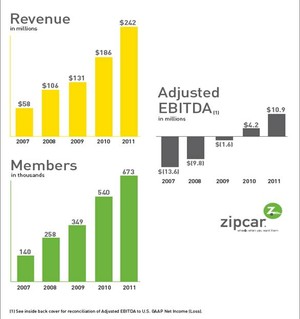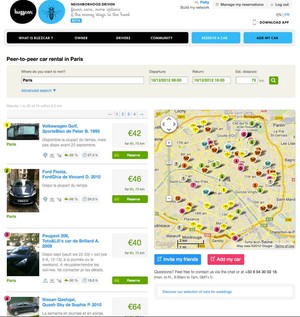BuzzCar—Peer-to-Peer Car Rental
Building a Platform for Participation for a “Peers Inc.” Business Model
Buzzcar is a company designed around a peer-to-peer community of people who are willing to rent out their cars to other people when they’re not driving them. This is the story of Buzzcar told by Robin Chase, Buzzcar’s founder. She describes Buzzcar as a “Peers Inc.” company. In a Peers Inc. business, individuals provide services and products on a platform for participation that’s provided by a company. The company does what big companies do best—they scale and manage risk. The customers do what they do best: they provide innovative and specialized solutions.
NETTING IT OUT
What can we learn from a car-sharing business in France? Quite a lot! Buzzcar was founded by a proven entrepreneur—the co-founder of Zipcar, the world’s largest car-sharing network. But Buzzcar is more than an encore for Robin Chase. She is pushing the envelope in two ways:
1. Buzzcar moves beyond the “pick-up-a Zipcar-rent-by-the-hour-and-return-it-to-the-same-place” model, which is capital-intensive, to a “rent-from-a-neighbor-whose-car-is-available” model which requires no capital investment in cars and parking spaces.
2. Robin Chase has studied peer-to-peer business models and come to the conclusion that the real multiplier effect isn’t just from creating a marketplace in which consumers can buy and sell products and services to one another. You can create a healthy customer ecosystem that will grow exponentially by using what Robin calls a “Peers Inc.” business model. It’s a company with a customer community at its core.
TWO DIFFERENT WAYS TO MAKE CAR USE MORE EFFICIENT
Zipcar Popularized Car-Sharing vs. Car Ownership
Robin Chase was the founder of Zipcar, a car-sharing company, which is now 12 years old and had revenues of $242 million in 2011. Zipcar currently parks 10,000 cars across the U.S., Canada, the U.K., Spain, and Austria, which are rented by the hour and driven by almost 1 million people. Robin is proud of the positive impact that Zipcar has had on the environment and on sustainability. “The most remarkable part about this, from an environmental standpoint is that each car replaces 15 or so cars, because 40% of people decide to sell their own cars and use Zipcar. People drive about 60% fewer miles than they otherwise would, because now they’re paying by the hour and by the day and the full cost of car ownership is there. So, for me, Zipcar has been an amazing success. I think the company is what has made people realize what sharing is all about. It has made car-sharing the norm.”
Although its services were innovative, Zipcar’s business model was pretty standard. The company provides the products and services to the customers who become members and use the services. Robin Chase’s current enthusiasm is for a different kind of business model that she has dubbed: “Peers-to-Peers, Inc.” in which the customers provide the products and services, and the company provides the “platform for participation.”
(Click on image to enlarge.)
© 2012 Zipcar, Inc.
1. Zipcar went public in 2011. Here’s a graph summarizing its growth from its 2011 Annual Report. Note that the Boston-based company grew from $58 million in revenues and 140,000 members to $242 million and 673,000 members.
Buzzcar Is Pioneering Peer-to-Peer Car-Sharing and a New Business Model
Robin’s new company is Buzzcar, which she launched in France on June 1st, 2011. It’s a different kind of car-sharing service: one in which people share their own cars with one another. “Buzzcar pushes the envelope and takes it to a different level.” With Zipcar, the company invested in cars and parking for them, as well as the software and services that make it easy for people to find and rent them. But, with Buzzcar, Robin explained, “we invest in the community instead of the cars, and individuals rent their own cars to their neighbors. If you think of excess capacity—what’s out there is that cars are driven about 5% of the time. They’re sitting all the rest of the time. Buzzcar puts the power of autonomy to car-share in the hands of individuals. So, as an individual, if I have a car, I’m the one who decides that I’m going to open it up for other people to use. And, if I’m a person who wants to drive a car, I can find a neighbor who wants to lend it to me.”
Now, 15 months later, Buzzcar has 1,400 cars and 11,000 members in many parts of France. But what really has Robin Chase juiced is her discovery of what she has now dubbed the “Peers Inc.” business model.
© 2012 Buzzcar, Inc.
2. Buzzcar started operation in France in June 2011. You can find cars available from their owners in many French cities and towns. The numbered circles show some cars that are available in Paris for a full day’s rental (8 hours) on October 12th, 2012. The remaining circles (with insects on them) are Buzzcar car-renters nearby.
BUSINESS MODEL FOR CUSTOMER INNOVATION: “PEERS-TO-PEERS, INC”
What’s a Peers-to-Peers Inc. Business Model?
Robin Chase describes this new business model this way…
Sign in to download the full article
0 comments
Be the first one to comment.





